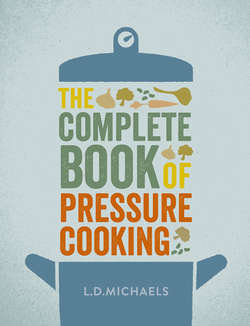Читать книгу The Complete Book of Pressure Cooking - L.D. Michaels - Страница 25
Оглавление5 SOUPS AND STOCKS
I really can’t remember when I last made a soup merely by opening an aluminium-foil pack containing powdered and dried ingredients, a can or even the luxury versions in waxed paper cartons – and that isn’t just cookery writers’ snobbery. There simply hasn’t been any point; not only are home-produced soups vastly better in every respect, but with a pressure cooker they need take hardly any longer to get to table than the so-called “convenience” versions.
Soups need not be the thin, ghostly apologies we are used to; they are marvellous appetizers when taken as clear hot liquids at the beginning of a meal, enlivening the taste buds for the things to come. They can provide a meal in themselves when thickened up with vegetables and meat chunks and with croutons floating on them. They can be used as an instant restorative after hard physical work, exposure to cold weather or illness – the hot fluid rapidly warms the body and the constituents are usually easily digested. The Chinese have broth at the end of a meal to clear the mouth and aid settling of the stomach.
Soups can be made from all manner of leftovers and oddments that would normally be thrown away. Most of the cost of commercially packaged soups goes into the packaging; then there is the advertising that the food manufacturers or processors have to invest in to get you to buy their particular product rather than their rivals’, the costs of distribution, warehousing and the retailer’s mark-up. Precious little of what you pay goes into the food itself.
Normally, soup making in the home, particularly if it involves meat, is a long process. The pressure cooker, optionally joined by the blender, has changed all this. No single category of food illustrates the versatility of the pressure cooker as well, or the variety of ways in which it can be used.
The pressure cooker can make you meat soups in 7–8 minutes, vegetable soups in 5 minutes; it can produce first-rate meat stock in 40–50 minutes, and even a marrowbone stock in 2 hours (against 12 hours by other methods). You can have clear soups and thick ones, and you can try your hand at unusual fish soups and even ones based on fruit (a particular favourite of mine). Soups can be hot, cold or jellied.
Degreasing
One technique within soup making (and it can also apply to stews of various kinds) you will need to acquire, if you don’t have it already, is degreasing. Cooked meat throws off fat and excess fat may also occur if you pre-sauté vegetables. To remove grease while still hot, roll up a length of kitchen paper and mop the surface of the fluid, snipping off the end of the paper as it becomes soaked. Better and easier, cool the liquid rapidly so that the fat rises to the surface – place in a bowl and stand in iced water. You can then use a shallow ladle to scoop from the top – there are ones designed specifically for the purpose and have carefully positioned slots. There are also specially designed separator jugs with spouts that decant from the bottom – some of these also have filters to trap small unwanted pieces of food.
